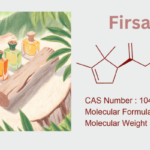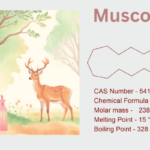1. Introduction: The Allure of Muscone in Perfumery
For ages, chemists and perfumers have been fascinated with muscone, the chemical responsible for the mysterious and classic aroma of musk. This macrocyclic ketone, which was once only found in the glands of the endangered musk deer, today represents the victory of synthetic chemistry over moral and environmental issues. The warm, sensual, and timeless scent of muscone, a mainstay of luxury fragrances, continues to influence the olfactory environment. This article explores the chemistry, synthesis, and uses of muscone, showing how science has protected the environment while preserving the essence of musk.
2. Chemical Identity: The Architecture of Muscone
Muscone, which has a single ketone functional group and a 15-membered carbon ring, is a member of the macrocyclic ketone family (C₁₆H₃₀O). Important structural elements consist of:
- Large Cyclic Framework: Van der Waals forces maintain the 15-carbon ring, giving it remarkable skin lifespan.
- Chirality: The (-)-enantiomer of muscone is found in nature, although synthesized forms are frequently racemic mixes.
- Low Volatility: Boiling point of ~328°C, making it an ideal base note in perfumery.
Muscone’s capacity to engage with olfactory receptors and provide a gentle, animalic warmth that is different from harsher musks like civetone is supported by this structure.
3. Synthesis of Muscone: From Deer Glands to Lab Benches
Historical Extraction from Musk Deer
- Source: Secretions from the preputial gland of male Moschus deer.
- Ethical Issues: CITES banned commerce when overhunting brought the species dangerously close to extinction.
Modern Synthetic Routes
- Ruzicka Cyclization:
- Process: The macrocyclic ring is formed by heating a dicarboxylic acid, such as 15-hydroxypentadecanoic acid, to cause cyclization.
- Catalyst: Tin oxide or titanium tetrachloride.
- Yield: ~60–70%, requiring purification via distillation.
- Biotechnological Methods:
- Engineered Yeast: Through fatty acid biosynthetic routes, modified Saccharomyces cerevisiae generates macrocyclic ketones.
- Sustainability: Reduces reliance on petrochemical feedstocks.
- Ring-Closing Metathesis (RCM):
- Catalyst: Grubbs catalyst facilitates carbon-carbon bond formation.
- Precursor: dienes cyclized into muscone’s 15-membered ring.
Purification:
- Chromatography: Silica gel columns remove linear byproducts.
- Crystallization: Ethanol/water mixtures yield >99% purity.
4. Natural Sources: The Shadow of the Musk Deer
While synthetic muscone dominates today, its origins lie in nature:
- Musk Deer: Moschus species in Siberia and the Himalayas. One gland produces about 25g of musk pod, which contains 1% to 2% muscone.
- Plant Alternatives: Although it is not commercially viable, trace muscone is occasionally detected in the roots of Angelica archangelica.
Ethical Shift: CITES Appendix I (1979) banned trade of natural musk, accelerating synthetic muscone’s rise.
5. Odor Profile: The Scent of Sensuality
Muscone’s aroma is a study in paradox—animalic yet refined, potent yet subtle:
- Top Notes: Clean, slightly metallic freshness.
- Heart: Warm, powdery, and skin-like, evoking human pheromones.
- Base: Deep, velvety sweetness with a leathery undertone.
Because of its smoothness, muscone is a common ingredient in both gender-neutral and high-end perfumes, in contrast to harsh animalic musks like civet.
6. Uses: Beyond the Perfume Atomizer
Perfumery:
- Base Note: fixated on classic scents such as Narciso Rodriguez’s For Her and Chanel’s No. 5.
- Accord Blending: complements woods (cedar, sandalwood) and flowers (rose, jasmine).
Cosmetics:
- Lotions and Creams: Enhances longevity of citrus or herbal top notes.
- Soaps: Provides a lingering, sophisticated dry-down.
Functional Products:
- Detergents and Fabric Softeners: Masks chemical odors with a subtle musk.
7. Percentage in Fragrances: The Delicate Balance of Potency
Muscone’s intensity demands meticulous dosing:
- Fine Fragrances: 0.1 to 1.0 percent of the formula. It makes up around 0.5% of Aventus by Creed.
- Cosmetics: 0.05–0.3% in leave-on products (e.g., serums).
- Functional Products: <0.1% in detergents due to cost.
IFRA Guidelines:
- Perfumers rarely go over 2% to prevent olfactory tiredness, but this is regarded as safe with no concentration limits.
8. Challenges and Innovations
Sustainability:
- Green Catalysis: Enzymatic cyclization reduces reliance on heavy metal catalysts.
- Waste Reduction: Solvent recycling in RCM processes.
Regulatory Landscape:
- REACH Compliance: guarantees that nitromusk contaminants—which are prohibited because of their toxicity—are absent from synthetic muscone.
Future Directions:
- Molecular Encapsulation: Slow-release muscone in smart textiles.
- AI-Driven Formulation: Algorithms predict optimal muscone blends for target markets.
9. Conclusion: Muscone’s Timeless Legacy
Muscone’s journey, from the Himalayan heights to gas chromatographs, represents humanity’s attempt to balance innovation and environment. This molecule continues to be a monument to the alchemical core of fragrance, even as green chemistry and synthetic biology alter its manufacture. Sophia Grojsman, a perfumer, described musk as “the silence between the notes.” Muscone’s silent strength never stops speaking.










